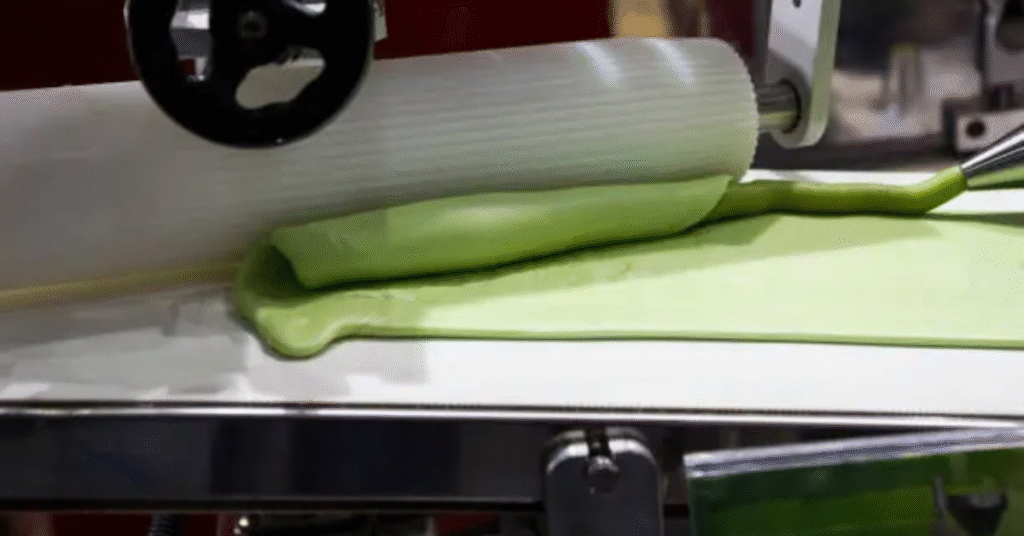Dough moulding compound (DMC) is an advanced thermosetting material used extensively across industries like automotive, electrical, and consumer goods for its high strength, insulating properties, and dimensional stability. For manufacturers seeking precision components, DMC offers a balance of lightweight structure and mechanical performance, making it ideal for complex moulded parts. In this article, we delve into what DMC is, how it’s produced, its advantages, emerging uses, and why it’s playing a growing role in sustainable industrial production. Whether you’re an engineer, supplier, or sustainability advocate, understanding DMC gives insight into the future of composite manufacturing.
What Is Dough Moulding Compound?
Dough moulding compound is a ready-to-use, thermosetting composite made from a mix of unsaturated polyester resin, inert fillers, fiber reinforcements (usually glass fibers), and various additives. The result is a pliable, dough-like material that can be moulded under heat and pressure to form rigid components.
Unlike thermoplastics, DMC doesn’t soften once cured. Its final structure is chemically cross-linked, offering excellent resistance to heat, chemicals, and moisture. Because of this, DMC is widely used for electrical switchgear, lighting housings, car parts, and more.
Composition of DMC:
| Component | Function |
|---|---|
| Unsaturated Polyester | Acts as the resin matrix or binding agent |
| Glass Fibers | Provide mechanical strength and rigidity |
| Fillers (e.g., calcium carbonate) | Reduce cost and improve fire resistance |
| Additives (e.g., catalysts, lubricants, pigments) | Enhance flow, curing, appearance, or resistance properties |
These ingredients are mixed to form a homogenous, non-tacky, dough-like consistency. This form allows easy handling, automation, and consistent performance.
Evolution of DMC in Composite Manufacturing
The concept of thermoset moulding materials dates back to the early 20th century with the development of phenolic resins. Over decades, DMC emerged as an evolution in composite materials, addressing the need for:
- Greater automation potential in moulding
- Improved surface finish and dimensional stability
- High-volume production without compromising part performance
Today, with increasing demands for sustainable, efficient, and high-strength materials, DMC continues to evolve. Bio-based resins, recycled fillers, and low-emission curing agents are now becoming standard in next-generation DMC formulations.
Why Manufacturers Prefer DMC
DMC offers several advantages over traditional materials like metal, ceramic, or basic plastics. These include:
- Mechanical Strength: High tensile and flexural strength due to embedded glass fibers.
- Thermal Stability: Can withstand continuous use temperatures up to 150°C or higher.
- Electrical Insulation: Excellent dielectric properties, making it ideal for circuit breakers and electrical housings.
- Corrosion Resistance: Unlike metals, DMC does not rust or degrade in harsh chemical environments.
- Precision Moulding: High dimensional accuracy due to low shrinkage and good flow characteristics.
This combination of properties makes DMC suitable for cost-effective, high-performance parts in demanding conditions.
Common Applications Across Industries
DMC’s versatility is evident in its widespread use across sectors. Here’s a breakdown by application type:
| Industry | Common DMC Applications |
|---|---|
| Automotive | Headlamp reflectors, wiper arms, motor housings |
| Electrical | Circuit breakers, switchgear, terminal blocks |
| Consumer Goods | Cooking appliance handles, hairdryer housings, bathroom accessories |
| Industrial | Pump impellers, compressor vanes, control panel components |
| Construction | Wall panels, HVAC ducting, fasteners for non-corrosive environments |
Processing DMC: From Compound to Final Product
The moulding of DMC typically involves compression or injection moulding. Let’s explore the processing steps:
- Preparation: The DMC is prepared in bulk form or as pre-weighed slugs or pellets.
- Preheating (optional): Sometimes used to improve flow and reduce cycle times.
- Moulding: The compound is placed into a heated mould (typically between 140–180°C) and compressed.
- Curing: Heat triggers the chemical cross-linking, solidifying the structure.
- Ejection: Once cured (within seconds to minutes), the part is removed.
- Post-Processing: Trimming, surface finishing, or painting may follow depending on the application.
This process results in a robust, ready-to-use component with tight tolerances and smooth finishes.
Compression vs Injection Moulding for DMC
DMC is flexible enough for different moulding technologies. However, its doughy texture gives it an edge in compression moulding over sheet moulding compounds (SMCs) or thermoplastics.
Comparison Table:
| Parameter | Compression Moulding | Injection Moulding |
|---|---|---|
| Ideal For | Thick, robust parts | Thin-walled, detailed parts |
| Tooling Cost | Moderate | High |
| Cycle Time | Short (30s–2 min) | Very short (10–60s) |
| Surface Finish | Excellent | Very good |
| Volume Suitability | Medium to high | Very high |
Manufacturers often choose the method based on volume requirements, complexity, and desired finish.
Advances in DMC Formulations
The traditional DMC relied on petroleum-derived polyester resins and synthetic glass fibers. However, with environmental concerns rising, modern formulations now include:
- Bio-Based Resins: Derived from corn, soy, or cashew oil to reduce carbon footprint.
- Natural Fiber Reinforcements: Hemp, jute, or flax used in place of synthetic glass fibers.
- Low-Styrene Emission Resins: Minimizes workplace exposure and VOC emissions.
- Nano-Additives: Improve strength, fire resistance, and even antimicrobial properties.
These innovations are helping DMC retain its relevance in the age of green manufacturing.
DMC vs Competing Materials
How does DMC stack up against other common manufacturing materials?
| Material | Advantages of DMC Over Competitor |
|---|---|
| Thermoplastics | Higher thermal resistance, rigidity, and dimensional accuracy |
| Sheet Moulding Compound (SMC) | Better suited for small, intricate parts due to flow behavior |
| Aluminum | Corrosion-resistant, lighter, and electrically insulating |
| Ceramics | Less brittle, lower cost, and easier to process |
For small to medium-sized parts with structural and insulation needs, DMC often proves superior.
Sustainability and the Circular Economy
Though thermosets are generally considered non-recyclable due to their cross-linked structure, DMC is finding its place in the circular economy through:
- Mechanical Recycling: Regrinding offcuts to use as filler in new compounds.
- Energy Recovery: High calorific value enables use in industrial incineration with energy capture.
- Closed-loop Manufacturing: Some companies reclaim post-industrial DMC waste for reuse.
In addition, initiatives are underway to develop thermosetting matrices that are fully recyclable through chemical depolymerization.
Challenges Facing DMC Adoption
While DMC holds many advantages, it is not without its limitations:
- Brittleness: Compared to some thermoplastics, DMC can be less impact-resistant.
- Tooling Wear: Glass fibers and abrasive fillers can degrade mould surfaces over time.
- Shelf Life: DMC has a limited shelf life and must be stored properly to prevent premature curing.
- Color Matching: Because DMC cures through an exothermic process, exact color control can be challenging.
Despite these, ongoing research continues to address each limitation through additives, hybrid resins, and better storage solutions.
Market Trends and Economic Outlook
With growing demand for lightweight, high-strength materials, the DMC market is projected to expand significantly in the next decade. Key factors include:
- Electric Vehicles (EVs): Lightweight and insulating properties make DMC ideal for battery enclosures and EV motor parts.
- Infrastructure Expansion: Smart cities and green buildings require materials with durability, insulation, and fire resistance.
- Global Electrification: As energy grids modernize, the demand for electrical housings, switchgear, and insulation materials increases.
Moreover, as automation continues to dominate production lines, DMC’s compatibility with robotic handling and short curing cycles makes it a strategic choice.
The Human Element: Skills and Expertise
Producing and moulding DMC requires specific expertise across disciplines:
- Material Scientists: Develop custom formulations for specific performance goals.
- Tool Designers: Create moulds that optimize flow, curing, and part ejection.
- Mould Technicians: Operate compression and injection equipment while ensuring quality standards.
- Sustainability Officers: Ensure that new formulations meet regulatory and environmental benchmarks.
Associations and training bodies now offer specialized courses in advanced composites, including DMC processing and sustainability practices.
Innovation Spotlight: Hybrid DMC
Researchers are working on “hybrid DMC”—materials that combine DMC with other polymer systems or smart fillers to enhance performance.
Examples include:
- Self-Healing DMC: Microencapsulated healing agents embedded in the matrix.
- Conductive DMC: Enhanced with carbon nanotubes or metal particles for partial conductivity.
- Thermally Conductive DMC: For heat-dissipating housings in power electronics.
These developments signal the next phase of DMC as more than just a structural or insulating material—it’s evolving into a multifunctional composite.
Future Outlook: DMC in Emerging Technologies
As industries shift toward automation, electrification, and climate-responsive infrastructure, DMC’s role is expected to deepen.
Emerging applications include:
- 5G Infrastructure: Non-metallic housings for antennas and base stations.
- Smart Appliances: Integrated with sensors, requiring heat-resistant non-metal parts.
- Medical Equipment: Biocompatible and sterilization-resistant DMC parts for imaging and support devices.
The continued integration of AI in design and manufacturing also allows for simulation-driven development, reducing waste and accelerating new part creation.
Conclusion: Why DMC Matters Now
Dough moulding compound represents a unique intersection of performance, versatility, and sustainability. It supports precision manufacturing in a broad range of sectors, offering high thermal and mechanical performance with excellent electrical insulation. As industries evolve toward smarter, greener, and more efficient production, DMC provides a material solution that meets both functional and environmental goals.
Manufacturers, designers, and material scientists would do well to keep DMC on their radar—not just as a legacy material, but as a forward-looking composite ready to meet the demands of modern manufacturing.







